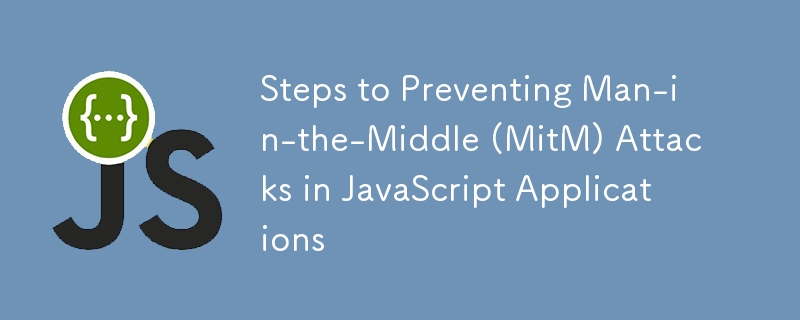防止 JavaScript 應用程式中的中間人 (MitM) 攻擊的步驟

中间人 (MitM) 攻击对网络安全构成重大威胁。在这些攻击中,恶意行为者拦截客户端和服务器之间的通信,从而允许他们窃听、操纵或窃取数据。本博客将探讨 MitM 攻击如何在 JavaScript 应用程序上下文中发挥作用,并提供实际步骤来保护您的应用程序免受这些威胁。
什么是中间人攻击?
当攻击者秘密拦截并中继相信彼此直接通信的两方之间的消息时,就会发生中间人攻击。这种拦截可能会导致未经授权访问敏感数据,例如登录凭据、财务信息和个人详细信息。
中间人攻击如何运作
MitM 攻击可以通过多种方式执行,包括:
1。 DNS 欺骗: DNS 欺骗涉及更改 DNS 记录以将用户重定向到恶意网站。
例子:
假设您已在 xyz.com 上部署了 Node.js 和 React 应用程序。黑客可以操纵 DNS 记录,以便当用户尝试访问 xyz.com 时,他们会被重定向到与您的网站看起来相同的恶意网站。
防止 DNS 欺骗的步骤:
- 使用 DNSSEC(域名系统安全扩展)添加额外的安全层。
- 定期监控和更新您的 DNS 记录。
- 使用信誉良好的 DNS 提供商,提供针对 DNS 欺骗的安全功能。
# Example of enabling DNSSEC on your domain using Cloudflare # Visit your domain's DNS settings on Cloudflare # Enable DNSSEC with a single click
2. IP 欺骗
IP 欺骗涉及冒充受信任的 IP 地址来拦截网络流量。
例子:
攻击者可能会欺骗您服务器的 IP 地址来拦截您的客户端和 Node.js 服务器之间的流量。
防止 IP 欺骗的步骤:
- 实施 IP 白名单,仅允许受信任的 IP 地址与您的服务器通信。
- 使用网络级安全措施,例如 VPN 和防火墙。
- 确保服务器上的 IP 地址正确验证和过滤。
// Example of IP whitelisting in Express.js
const express = require('express');
const app = express();
const allowedIPs = ['123.45.67.89']; // Replace with your trusted IPs
app.use((req, res, next) => {
const clientIP = req.ip;
if (!allowedIPs.includes(clientIP)) {
return res.status(403).send('Forbidden');
}
next();
});
// Your routes here
app.listen(3000, () => {
console.log('Server is running on port 3000');
});
3. HTTPS 欺骗
HTTPS 欺骗涉及创建虚假 SSL 证书来冒充安全网站。
例子:
攻击者可以为 xyz.com 创建伪造的 SSL 证书,并设置一个看起来与您的合法服务器相同的恶意服务器。
防止 HTTPS 欺骗的步骤:
- 使用证书透明度来监控和记录为您的域颁发的所有证书。
- 实施 HTTP 公钥固定 (HPKP),将 Web 服务器的加密公钥与一组特定的 HTTPS 网站关联起来。
// Example of implementing HPKP in Express.js
const helmet = require('helmet');
const app = express();
app.use(helmet.hpkp({
maxAge: 60 * 60 * 24 * 90, // 90 days
sha256s: ['yourPublicKeyHash1', 'yourPublicKeyHash2'], // Replace with your public key hashes
includeSubDomains: true
}));
// Your routes here
app.listen(3000, () => {
console.log('Server is running on port 3000');
});
4。 Wi-Fi 窃听
Wi-Fi 窃听涉及拦截通过不安全的 Wi-Fi 网络传输的数据。
例子:
黑客可能会设置恶意 Wi-Fi 热点,并在用户连接到您的服务器时拦截用户和您的服务器之间传输的数据。
防止 Wi-Fi 窃听的步骤:
- 鼓励用户仅连接到安全的 Wi-Fi 网络。
- 实施端到端加密(E2EE)以保护客户端和服务器之间传输的数据。
- 使用 VPN 加密客户端和服务器之间的流量。
// Example of enforcing HTTPS in Express.js
const express = require('express');
const app = express();
app.use((req, res, next) => {
if (req.headers['x-forwarded-proto'] !== 'https') {
return res.redirect(['https://', req.get('Host'), req.url].join(''));
}
next();
});
// Your routes here
app.listen(3000, () => {
console.log('Server is running on port 3000');
});
防止 JavaScript 应用程序中的中间人攻击
1。到处使用 HTTPS
确保客户端和服务器之间的所有通信均使用 HTTPS 加密。使用 Let's Encrypt 等工具获取免费的 SSL/TLS 证书。
// Enforce HTTPS in Express.js
const express = require('express');
const app = express();
app.use((req, res, next) => {
if (req.headers['x-forwarded-proto'] !== 'https') {
return res.redirect(['https://', req.get('Host'), req.url].join(''));
}
next();
});
// Your routes here
app.listen(3000, () => {
console.log('Server is running on port 3000');
});
2.验证 SSL/TLS 证书
对 SSL/TLS 证书使用强验证并避免在生产中使用自签名证书。
3.实施内容安全策略 (CSP)
使用 CSP 标头来限制应用程序可以加载资源的来源,从而降低恶意脚本注入的风险。
// Setting CSP headers in Express.js
const helmet = require('helmet');
app.use(helmet.contentSecurityPolicy({
directives: {
defaultSrc: ["'self'"],
scriptSrc: ["'self'", 'trusted.com'],
styleSrc: ["'self'", 'trusted.com']
}
}));
4。使用安全 Cookie
确保 cookie 被标记为 Secure 和 HttpOnly,以防止通过客户端脚本访问它们。
// Setting secure cookies in Express.js
app.use(require('cookie-parser')());
app.use((req, res, next) => {
res.cookie('session', 'token', { secure: true, httpOnly: true });
next();
});
5。实施 HSTS(HTTP 严格传输安全)
使用 HSTS 强制浏览器仅通过 HTTPS 与您的服务器通信。
// Setting HSTS headers in Express.js
const helmet = require('helmet');
app.use(helmet.hsts({
maxAge: 31536000, // 1 year
includeSubDomains: true,
preload: true
}));
中间人攻击可能会给 Web 应用程序带来毁灭性后果,导致数据盗窃和注入攻击。通过了解这些攻击的工作原理并实施强大的安全措施,您可以保护您的 JavaScript 应用程序并确保用户数据的安全。始终使用 HTTPS、验证 SSL/TLS 证书、实施 CSP、安全 cookie 并强制实施 HSTS 以减轻 MitM 攻击的风险。
-
 如何處理PHP文件系統功能中的UTF-8文件名?在PHP的Filesystem functions中處理UTF-8 FileNames 在使用PHP的MKDIR函數中含有UTF-8字符的文件很多flusf-8字符時,您可能會在Windows Explorer中遇到comploreer grounder grounder grounder gro...程式設計 發佈於2025-03-28
如何處理PHP文件系統功能中的UTF-8文件名?在PHP的Filesystem functions中處理UTF-8 FileNames 在使用PHP的MKDIR函數中含有UTF-8字符的文件很多flusf-8字符時,您可能會在Windows Explorer中遇到comploreer grounder grounder grounder gro...程式設計 發佈於2025-03-28 -
 如何使用組在MySQL中旋轉數據?在關係數據庫中使用mySQL組使用mySQL組進行查詢結果,在關係數據庫中使用MySQL組,轉移數據的數據是指重新排列的行和列的重排以增強數據可視化。在這裡,我們面對一個共同的挑戰:使用組的組將數據從基於行的基於列的轉換為基於列。 Let's consider the following ...程式設計 發佈於2025-03-28
如何使用組在MySQL中旋轉數據?在關係數據庫中使用mySQL組使用mySQL組進行查詢結果,在關係數據庫中使用MySQL組,轉移數據的數據是指重新排列的行和列的重排以增強數據可視化。在這裡,我們面對一個共同的挑戰:使用組的組將數據從基於行的基於列的轉換為基於列。 Let's consider the following ...程式設計 發佈於2025-03-28 -
 為什麼我的CSS背景圖像出現?故障排除:CSS背景圖像未出現 ,您的背景圖像儘管遵循教程說明,但您的背景圖像仍未加載。圖像和样式表位於相同的目錄中,但背景仍然是空白的白色帆布。 而不是不棄用的,您已經使用了CSS樣式: bockent {背景:封閉圖像文件名:背景圖:url(nickcage.jpg); 如果您的html,cs...程式設計 發佈於2025-03-28
為什麼我的CSS背景圖像出現?故障排除:CSS背景圖像未出現 ,您的背景圖像儘管遵循教程說明,但您的背景圖像仍未加載。圖像和样式表位於相同的目錄中,但背景仍然是空白的白色帆布。 而不是不棄用的,您已經使用了CSS樣式: bockent {背景:封閉圖像文件名:背景圖:url(nickcage.jpg); 如果您的html,cs...程式設計 發佈於2025-03-28 -
 如何在全高佈局中有效地將Flexbox和垂直滾動結合在一起?在全高佈局中集成flexbox和垂直滾動Traditional Flexbox Approach (Old Properties)Flexbox layouts using the old syntax (display: box) permit full-height apps with ver...程式設計 發佈於2025-03-28
如何在全高佈局中有效地將Flexbox和垂直滾動結合在一起?在全高佈局中集成flexbox和垂直滾動Traditional Flexbox Approach (Old Properties)Flexbox layouts using the old syntax (display: box) permit full-height apps with ver...程式設計 發佈於2025-03-28 -
 如何使用Python理解有效地創建字典?在python中,詞典綜合提供了一種生成新詞典的簡潔方法。儘管它們與列表綜合相似,但存在一些顯著差異。 與問題所暗示的不同,您無法為鑰匙創建字典理解。您必須明確指定鍵和值。 For example:d = {n: n**2 for n in range(5)}This creates a dict...程式設計 發佈於2025-03-28
如何使用Python理解有效地創建字典?在python中,詞典綜合提供了一種生成新詞典的簡潔方法。儘管它們與列表綜合相似,但存在一些顯著差異。 與問題所暗示的不同,您無法為鑰匙創建字典理解。您必須明確指定鍵和值。 For example:d = {n: n**2 for n in range(5)}This creates a dict...程式設計 發佈於2025-03-28 -
 為什麼PYTZ最初顯示出意外的時區偏移?與pytz 最初從pytz獲得特定的偏移。例如,亞洲/hong_kong最初顯示一個七個小時37分鐘的偏移: 差異源利用本地化將時區分配給日期,使用了適當的時區名稱和偏移量。但是,直接使用DateTime構造器分配時區不允許進行正確的調整。 example pytz.timezone(&#...程式設計 發佈於2025-03-28
為什麼PYTZ最初顯示出意外的時區偏移?與pytz 最初從pytz獲得特定的偏移。例如,亞洲/hong_kong最初顯示一個七個小時37分鐘的偏移: 差異源利用本地化將時區分配給日期,使用了適當的時區名稱和偏移量。但是,直接使用DateTime構造器分配時區不允許進行正確的調整。 example pytz.timezone(&#...程式設計 發佈於2025-03-28 -
 如何配置Pytesseract以使用數字輸出的單位數字識別?Pytesseract OCR具有單位數字識別和僅數字約束 在pytesseract的上下文中,在配置tesseract以識別單位數字和限制單個數字和限制輸出對數字可能會提出質疑。 To address this issue, we delve into the specifics of Te...程式設計 發佈於2025-03-28
如何配置Pytesseract以使用數字輸出的單位數字識別?Pytesseract OCR具有單位數字識別和僅數字約束 在pytesseract的上下文中,在配置tesseract以識別單位數字和限制單個數字和限制輸出對數字可能會提出質疑。 To address this issue, we delve into the specifics of Te...程式設計 發佈於2025-03-28 -
 如何檢查對像是否具有Python中的特定屬性?方法來確定對象屬性存在尋求一種方法來驗證對像中特定屬性的存在。考慮以下示例,其中嘗試訪問不確定屬性會引起錯誤: >>> a = someClass() >>> A.property Trackback(最近的最新電話): 文件“ ”,第1行, AttributeError: SomeClass...程式設計 發佈於2025-03-28
如何檢查對像是否具有Python中的特定屬性?方法來確定對象屬性存在尋求一種方法來驗證對像中特定屬性的存在。考慮以下示例,其中嘗試訪問不確定屬性會引起錯誤: >>> a = someClass() >>> A.property Trackback(最近的最新電話): 文件“ ”,第1行, AttributeError: SomeClass...程式設計 發佈於2025-03-28 -
 如何在Java中執行命令提示命令,包括目錄更改,包括目錄更改?在java 通過Java通過Java運行命令命令可能很具有挑戰性。儘管您可能會找到打開命令提示符的代碼段,但他們通常缺乏更改目錄並執行其他命令的能力。 solution:使用Java使用Java,使用processBuilder。這種方法允許您:啟動一個過程,然後將其標準錯誤重定向到其標準輸出...程式設計 發佈於2025-03-28
如何在Java中執行命令提示命令,包括目錄更改,包括目錄更改?在java 通過Java通過Java運行命令命令可能很具有挑戰性。儘管您可能會找到打開命令提示符的代碼段,但他們通常缺乏更改目錄並執行其他命令的能力。 solution:使用Java使用Java,使用processBuilder。這種方法允許您:啟動一個過程,然後將其標準錯誤重定向到其標準輸出...程式設計 發佈於2025-03-28 -
 為什麼儘管有效代碼,為什麼在PHP中捕獲輸入?在php ;?>" method="post">The intention is to capture the input from the text box and display it when the submit button is clicked.但是,輸出...程式設計 發佈於2025-03-28
為什麼儘管有效代碼,為什麼在PHP中捕獲輸入?在php ;?>" method="post">The intention is to capture the input from the text box and display it when the submit button is clicked.但是,輸出...程式設計 發佈於2025-03-28 -
 如何在Java的全屏獨家模式下處理用戶輸入?Handling User Input in Full Screen Exclusive Mode in JavaIntroductionWhen running a Java application in full screen exclusive mode, the usual event ha...程式設計 發佈於2025-03-28
如何在Java的全屏獨家模式下處理用戶輸入?Handling User Input in Full Screen Exclusive Mode in JavaIntroductionWhen running a Java application in full screen exclusive mode, the usual event ha...程式設計 發佈於2025-03-28 -
 Python讀取CSV文件UnicodeDecodeError終極解決方法在試圖使用已內置的CSV模塊讀取Python中時,CSV文件中的Unicode Decode Decode Decode Decode decode Error讀取,您可能會遇到錯誤的錯誤:無法解碼字節 在位置2-3中:截斷\ uxxxxxxxx逃脫當CSV文件包含特殊字符或Unicode的路徑逃...程式設計 發佈於2025-03-28
Python讀取CSV文件UnicodeDecodeError終極解決方法在試圖使用已內置的CSV模塊讀取Python中時,CSV文件中的Unicode Decode Decode Decode Decode decode Error讀取,您可能會遇到錯誤的錯誤:無法解碼字節 在位置2-3中:截斷\ uxxxxxxxx逃脫當CSV文件包含特殊字符或Unicode的路徑逃...程式設計 發佈於2025-03-28 -
 找到最大計數時,如何解決mySQL中的“組函數\”錯誤的“無效使用”?如何在mySQL中使用mySql 檢索最大計數,您可能會遇到一個問題,您可能會在嘗試使用以下命令:理解錯誤正確找到由名稱列分組的值的最大計數,請使用以下修改後的查詢: 計數(*)為c 來自EMP1 按名稱組 c desc訂購 限制1 查詢說明 select語句提取名稱列和每個名稱...程式設計 發佈於2025-03-28
找到最大計數時,如何解決mySQL中的“組函數\”錯誤的“無效使用”?如何在mySQL中使用mySql 檢索最大計數,您可能會遇到一個問題,您可能會在嘗試使用以下命令:理解錯誤正確找到由名稱列分組的值的最大計數,請使用以下修改後的查詢: 計數(*)為c 來自EMP1 按名稱組 c desc訂購 限制1 查詢說明 select語句提取名稱列和每個名稱...程式設計 發佈於2025-03-28 -
 為什麼使用固定定位時,為什麼具有100%網格板柱的網格超越身體?網格超過身體,用100%grid-template-columns 為什麼在grid-template-colms中具有100%的顯示器,當位置設置為設置的位置時,grid-template-colly修復了? 問題: 考慮以下CSS和html: class =“ snippet-code”> ...程式設計 發佈於2025-03-28
為什麼使用固定定位時,為什麼具有100%網格板柱的網格超越身體?網格超過身體,用100%grid-template-columns 為什麼在grid-template-colms中具有100%的顯示器,當位置設置為設置的位置時,grid-template-colly修復了? 問題: 考慮以下CSS和html: class =“ snippet-code”> ...程式設計 發佈於2025-03-28 -
 如何使用Java.net.urlConnection和Multipart/form-data編碼使用其他參數上傳文件?使用http request 上傳文件上傳到http server,同時也提交其他參數,java.net.net.urlconnection and Multipart/form-data Encoding是普遍的。 Here's a breakdown of the process:Mu...程式設計 發佈於2025-03-28
如何使用Java.net.urlConnection和Multipart/form-data編碼使用其他參數上傳文件?使用http request 上傳文件上傳到http server,同時也提交其他參數,java.net.net.urlconnection and Multipart/form-data Encoding是普遍的。 Here's a breakdown of the process:Mu...程式設計 發佈於2025-03-28
學習中文
- 1 走路用中文怎麼說? 走路中文發音,走路中文學習
- 2 坐飛機用中文怎麼說? 坐飞机中文發音,坐飞机中文學習
- 3 坐火車用中文怎麼說? 坐火车中文發音,坐火车中文學習
- 4 坐車用中文怎麼說? 坐车中文發音,坐车中文學習
- 5 開車用中文怎麼說? 开车中文發音,开车中文學習
- 6 游泳用中文怎麼說? 游泳中文發音,游泳中文學習
- 7 騎自行車用中文怎麼說? 骑自行车中文發音,骑自行车中文學習
- 8 你好用中文怎麼說? 你好中文發音,你好中文學習
- 9 謝謝用中文怎麼說? 谢谢中文發音,谢谢中文學習
- 10 How to say goodbye in Chinese? 再见Chinese pronunciation, 再见Chinese learning

























